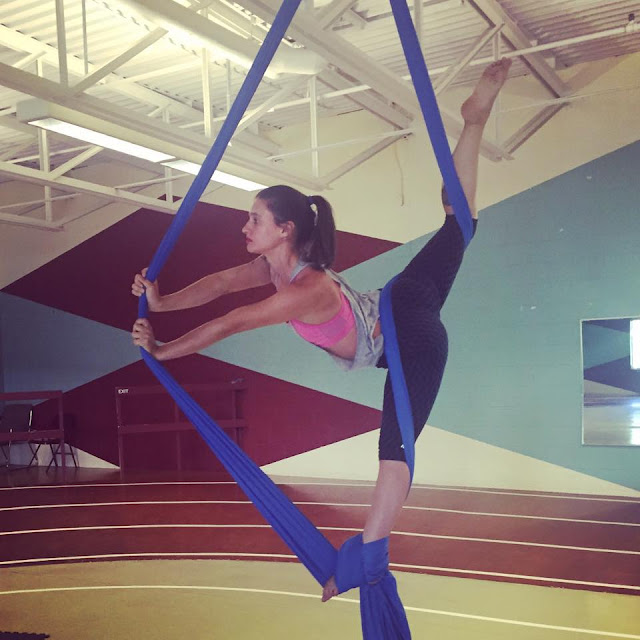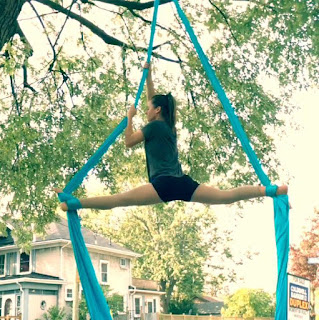That Elusive Straddle-Back Inversion
I've MOVED!!! Check out this post and more at my new website, AerFit.ca !!!
A straddle back inversion (AKA: Straddle Up, Straddle Inversion, V-Up...) is the holy grail for beginner aerialists. A display of strength, grace, and flexibility, it is the epitome of what we strive for as performers. But this is also one of those moves that tends to elude us, especially as beginners, as it requires extensive coordination and total body strength. And to make it look good, there are a million other things to consider such as technique, body position, extension, and flexibility.
First, for those who aren't aware, what exactly does a straddle-back inversion look like?
 |
| Me doing a Crossback Straddle Inversion with foot-locks. |
 |
| An Aerialist receiving instruction on doing straddle inversion with open fabric. |
 |
| From Laura Witwer's amazing blog. |
The image directly above^ shows a pretty perfect looking straddle inversion, with the fabric together. Pointed toes, straight legs, nice flexibility, high bottom, engaged lats/shoulders, and a smile!
But how did she get there? To achieve a nice looking straddle invert like the one pictured above, you need to start with a good foundation and build your way up. The muscle groups used in this particular move are, arms & grip, shoulders & lats, abdominal especially deep core muscles, and hip flexors. The two major groups being our abs and arms.
- The movement starts with your hands gripping the fabric to one side, and your bent arms held close into your chest. (You can also start with straight arms, though this is much more advanced)
- Next you make a clean sweeping motion with your legs into a straddle, bringing your bottom up high over your head.
- As this happens you extend your arms, while keeping engaged in the shoulders, back, and core.
- Extend your legs and point your toes!
- Try not to swear too much!
Straddle-back progressions are used as a tool to not only build strength but to also build confidence. Inverting on the fabric with only your grip strength holding you up is a huge mental challenge for beginners and a lot of the time a barrier between them and where they want to be. The progressions I use for myself and my students are:
KNOT Progressions
- Start in a knot. This will give you the confidence to invert safely even if your grip-strength is not-quite-there. Make sure the knot rests low on your back. To start, put your hands on the fabric in front of your face and push against it, using this as leverage to engage your deep abdominals and start lifting your legs. Int he beginning I usually recommend starting with "froggy legs", as I call them, this makes it easier to lift them up. Finally lift that bottom up high and extend your legs out straight making sure your feet are pointed and your knees aren't bent. From here, bend your legs again to the froggy shape, and slowly lower them back to the ground (or hanging for more of a challenge).
- Make the knot a bit higher. Do exactly as above, only on your way down keep your legs straight and engaged, bringing them to touch towards the bottom.
- Try inverting and coming down with your legs straight the entire time. Open to your straddle in the inverted position, and touch your feet together at the bottom.
GRIP Progressions (From the Ground)
- Hold the silk on one side of your body, close to your chest, with your arms bent. Grip position is usually a matter of preference. Bend your knees and lift them as high towards your chest as you can. Slowly lower your legs down. This is not a full straddle inversion, but an exercise you can do to help you build the core and upper body strength needed.
- Start as above. Lift your legs up in the frog position while pushing your bottom up nice and high in the air. Slowly extend your arms to a straight position, keep your shoulders engaged and away from your ears. Once inverted, extend the legs and point the toes. To come down, go back to your frog position and slowly lower your legs, returning your arms to a bent position close to your chest.
- Invert using your frog position, and come back to start position with straight legs.
- Invert and come down using straight legs the entire time. Once again opening to your straddle while you invert, and closing your legs to touch near the bottom.
Grip Progressions (In the Air)
- Exact same progressions as above, only you are in the air on the fabric and not on the ground. Make sure to have someone spot you while you practice for the first time.
- Straight arm, straight leg straddle ( I am still working on this myself)
Exercises to do at home or at the gym to build strength/Flexibility
- PULL UPS BABY. Build your grip and upper body strength by doing lots and lots of pull ups.
- MORE CORE. Make sure you are doing a variety of core exercises and not just crunches. This way you will target the entire abdomen and obliques. You want to focus on the lower deep abdominals used for lifting the legs.
- WORK those hip flexors! Do your leg lifts, individually and together. These are the ones I outlined in my at-home conditioning video. These start to work all those tiny stabilizer muscles that just may help you lift your legs up that last little bit.
- GRIP. It might be worth investing in a grip trainer. There are tons of youtube videos on improving your grip. Look 'em up!
- STRADDLE stretch series! Do the series from my conditioning video including the middle stretch with back straight, side to side, and the frog stretch. Also any stretch that opens your hips and works your hamstrings will help you improve as well.
- PLOW POSE! The yoga move called the "Plow" is a great way to get your body used to the straddle inversion movements. Try it with both hands down by your side and straight up above your head. Try it with straight legs and try opening to a straddle. Come in and out of the pose slowly and controlled.
Things to be aware of as you practice:
- DO NOT whip your head back to get momentum to invert. This is terrible for your neck and back, and frankly makes me dizzy.
- DO NOT jump into the straddle inversion every time. It doesn't work the right muscles when you rely on momentum. And when you get to the air, you will have nothing to jump from.
- DO NOT kick your fabric out of the way when you go to invert in the air. This looks terrible and is a bad habit. Sweep your legs to the side gracefully.
- DO NOT sink into your shoulders or let your bottom sag. Keep the shoulders engaged and away from your ears. keep your abs tight and lifting your bottom UP UP UP.
- DO NOT use your feet to grab and push the fabric to get you into position. That is another hard habit to break.
- DO NOT take a back beat before you invert. It is tempting but lazy. Once again momentum in this case prevents us from building the correct muscles and good technique.
- DO NOT try to practice when you are fatigued. You do not want your grip to fail when you are inverted and land on your head!
- DO point your toes and extend and engage your whole legs.
- DO stay hydrated and stop often to rest.
- DO have someone spot you when you are first learning.
- DO check out the list of resources I have posted below. Lot's of articles and videos of getting that elusive straddle back inversion!
Rain from Paper Doll Militia Demonstrates good technique and progressions
Jill with Aerial Physique demos beginner straddle invert in the knot.
Have fun inverting!
Samantha























0 comments: